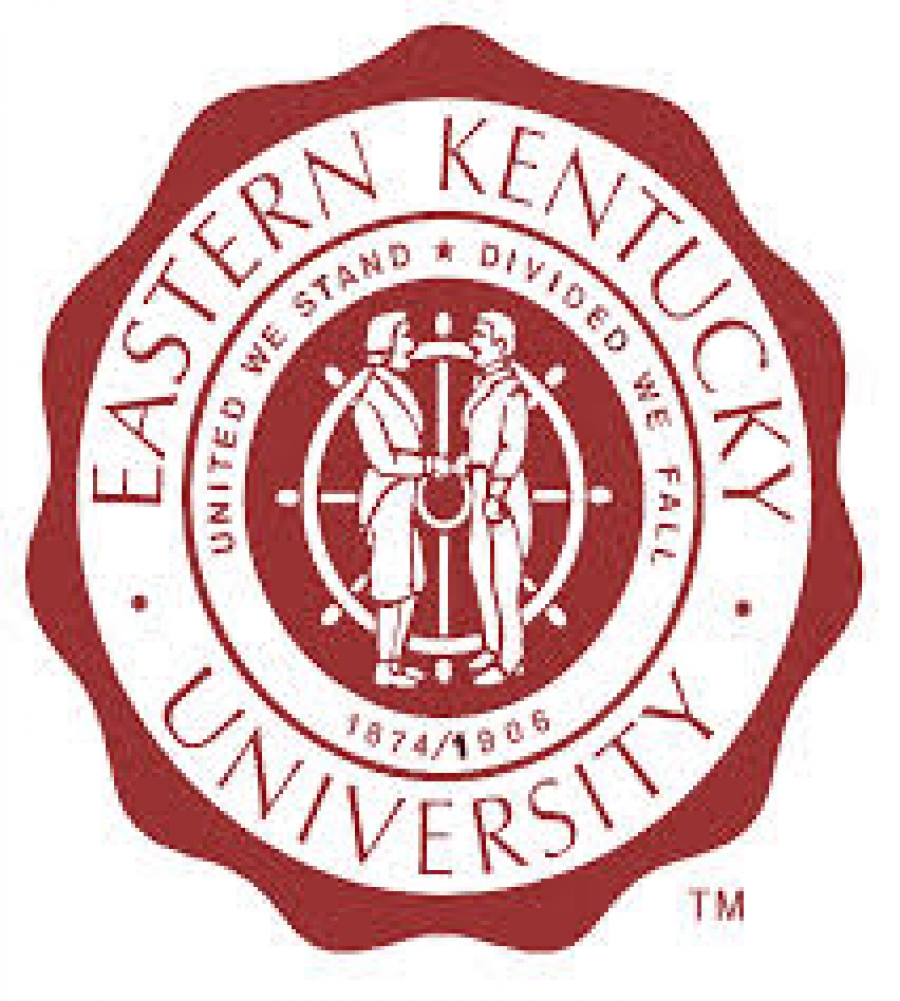
Field Course in Cetacean Ecology with Eastern Kentucky University
THIS PAGE IS CURRENTLY UNDER CONSTRUCTION. PLEASE CONTACT US FOR MORE DETAILS IF LINKS ARE NOT YET ACTIVE.
This page includes details on DCP’s 2018 seminar & field course with Eastern Kentucky University (EKU). All participants much register through EKU, however visiting students are encourage to apply.
Dates
TBD: Weekly on-site seminars @ EKU
29 May 2018- Arrive in Bimini, The Bahamas
10 June 2018 – Depart Bimini, The Bahamas
Included in Field
12 nights’ accommodation (steps away from beach and harbor), 3 meals/day (students assist with preparation and clean-up), 8 boat trips in search of wild dolphins, 1 boat trip to view Caribbean reef sharks, 3-credit hours from Eastern Kentucky University, course instruction, airport/hotel transportion (on Bimini only), rental snorkel gear (although we recommend you bring your own for a proper fit) and gratuity (hotel & boat staff). Please continue reading for details.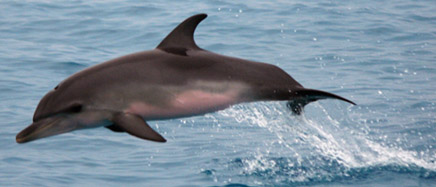
The course fee does not include air transportation to/from Bimini. However, the total cost ($TBD) does include 3 credits. Visiting students should inquire with their home university about the credit transfer process.
Eastern Kentucky University (EKU)
Check them out: http://www.eku.edu/
Instructors
Radhika Makecha, Ph.D., has been an Assistant Professor in EKU’s psychology department since 2013 and a DCP collaborator for many years. With a background in comparative psychology, Dr. Makecha will teach the seminar portion of this course and lead the field component.
Kelly Melillo Sweeting, MSc. has been researching Bimini’s dolphins with the Dolphin Communication Project since 2003. With a focus on interspecies interactions between the Atlantic spotted and bottlenose dolphins, Kel maintains DCP’s Bimini photo-ID catalog and leads research and education programs on Bimini.
The Island
The island, or more accurately islands, of Bimini lie less than 50 miles off the east coast of Florida. In fact, if you look to the west after sunset, you can see the lights of Miami. Bimini may be just a 20 minute plane ride from the U.S., but this most westerly inhabited island of The Bahamas feels a world away. Only a few hundred yards wide in some areas, Bimini is known for fishing, SCUBA diving and, of course, dolphins.

The Water
Bimini lies at the northwestern edge of the Great Bahama Bank, a vast area of warm, shallow water over a sandy seafloor. Portions of the island are made up of intricate mangrove systems, which in addition to great kayaking, are home to dozens of juvenile fish species. This important nursery ground is thought to be the source for many of the fish that grow up to populate other areas of The Bahamas. Immediately to the west of Bimini, and in stark contrast to the Great Bahama Bank, is the Gulf Stream (aka Florida Straights). The waters swiftly flowing north through this deep ocean trench provide a constant supply of “fresh” water and nutrients to the area, including fish such as mackerel and mahi mahi. It is thought that the dolphins around Bimini spend the majority of their time in the relative safety of the bank, while cruising out to deep water to feed.
The Dolphins
The group of Atlantic spotted dolphins (Stenella frontalis) studied by DCP off the coast of Bimini are thought to be resident animals – meaning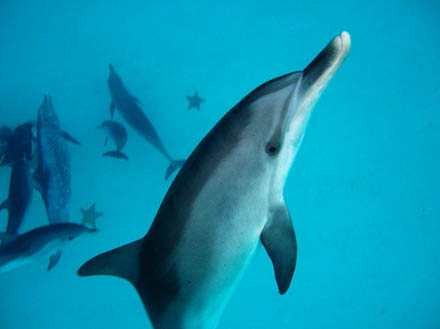 that each individual is born and raised, has its own calves and lives out the entirety of its life in the waters immediately surrounding Bimini. Although spotted dolphins are born without spots, they can be recognized by their individual spot pattern, which begins to develop around the age of 3 or 4 years. By documenting individuals through photographs and video, DCP can track the population over time and confirm that we do see the same individuals year after year. Since the animals develop new spots throughout their entire lives, it is important that DCP researchers are able to document as many individuals as possible each year.
that each individual is born and raised, has its own calves and lives out the entirety of its life in the waters immediately surrounding Bimini. Although spotted dolphins are born without spots, they can be recognized by their individual spot pattern, which begins to develop around the age of 3 or 4 years. By documenting individuals through photographs and video, DCP can track the population over time and confirm that we do see the same individuals year after year. Since the animals develop new spots throughout their entire lives, it is important that DCP researchers are able to document as many individuals as possible each year.
There are also common bottlenose dolphins (Tursiops truncatus) found off the coast of Bimini. At the moment, we know significantly less about these individuals, however, that is slowly changing. Members of this species are recognized by nicks in their dorsal fins, which are photographed as the animal breaks the surface to breathe. These photographs are supplemented with full body images from underwater video when possible. There does appear to be some residency pattern among what may be “coastal” bottlenose dolphins. It is also likely that there is an “offshore” bottlenose group, however their exact composition and interaction with the coastal dolphins is not known at this time.
Dolphin Communication Project
The Dolphin Communication Project (DCP) is focused on the dual goals of scientific research and education: we take results from research projects and disseminate them into educational programs for students of all ages. DCP has a team of researchers (graduated professionals, graduate students, undergraduate interns and volunteers) who work together to examine how dolphins communicate in order to shed more light on the meaning of the interactions between individuals and groups. We have 4 field sites that include wild and captive dolphins of 3 species. North Bimini Island in The Bahamas is one of these sites. Since 2001, we have been actively working with locally owned and operated eco-tour companies as part of a longitudinal study on the wild populations of Atlantic spotted (Stenella frontalis) and bottlenose dolphin s (Tursiops truncatus) in this area. Please contact u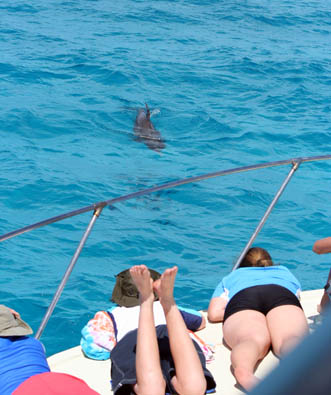 s for details.
s for details.
Sample Topics
- Behavioral and social ecology of cetaceans
- Dolphin species/Interspecies interactions
- Research methods and observational studies (behavioral ethograms, photo-id, video-acoustic recordings)
- Ecotourism, Conservation, and Human –Dolphin interactions, dolphin Cognition
- Dolphin Cognition
Daily Activities
Field work on Bimini generally consists of 4-5 hour boat trips in a pre-designated survey area. Lecture topics (listed above) are generally covered in the morning and evening hours, with boat surveys completed in the late afternoon. While on-board the survey vessel, students assist with posted watches, data sheets, GPS operation, etc. Once dolphins are in view, students take notes on depth, species, group size and composition, behaviors and known individuals. If the group is able to make underwater observations, students rotate in and out of the water, in pairs (for safety and cooperative learning) and using underwater slates and digital still cameras.
Lodging
Sea Crest Hotel and Marina. This locally owned and operated hotel is in historic Alice Town. The “suite,” with its cooking and living space, is used for meals and classroom time. Additional hotel rooms are added to supplement sleeping space. Standard hotel rooms have two double beds, ensuite bathroom, fresh water showers, A/C , TV. Generally 2 people per room, atlhough this cannot be guaranteed.
Travel
Please check with course instructors regarding group travel from Fort Lauderdale, FL to Bimini. US Citizens are required to travel with a valid passport. Birth certificates are no longer adequate for entry into The Bahamas. People with other citizenship should check with their native country. North Bimini is a short taxi (land and water) ride from the South Bimini airport. These taxi services run regularly and are included in the course fee.
Food
This program includes all meals. Students will participate in meal preparation and clean-up. We are able to accommodate most dietary restrictions (vegetarian, gluten-free, etc), but must know in advance (vegan, kosher cannot be guaranteed at every meal). Please inform us of any dietary restrictions at the time of registration. Snacks and drinking water are also provided on each boat trip.
Weather Conditions
Weather patterns in Bimini can be unpredictable, but during the summer, sea conditions tend to be consistently favorable. Squalls (rain, thunder, lightnight) can pass through the area, but are generally brief. June is the start of “hurricane season” and as such, the risk of major storms increases. Although Bimini does periodically experience tropical storms, full hurricanes are rare. There are no refunds for boat trips cancelled due to weather, however every effort will be made to offer alternative, active learning experiences. All participants should confirm with Dr. Yeater about insurance included (or not included) in the course fee.
Dolphin Sightings
The Atlantic spotted and bottlenose dolphins off Bimini, The Bahamas are wild. Therefore, there is no guarantee that we will see dolphins,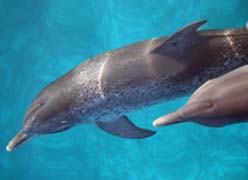 however the sighting success rate has been between 80-90% since 2003. Students will be exposed to the challenges of weather and subject dependent field work.
however the sighting success rate has been between 80-90% since 2003. Students will be exposed to the challenges of weather and subject dependent field work.
Money
In Bimini, the national currency is the Bahamian Dollar; however, U.S. dollars are accepted at a 1:1 ratio. The local bank can cash traveler’s checks for a small fee or provide cash advances on credit cards. There is also an operating ATM (but only one on the entire island!).
DEPOSITS/PAYMENTS/REFUNDS
A non-refundable deposit is required with your application. Contact us or EKU for details on the application process. There are no refunds for weather or illness.
General DCP Contact
Are you a university professor looking to bring your students to Bimini? Contact DCP at the info below:
Contact DCP’s Bimini Research Manager, Kel Melillo Sweeting via info {at} dcpmail {dot} org OR
Dolphin Communication Project
P.O. Box 7485
Port Saint Lucie, FL 34985
